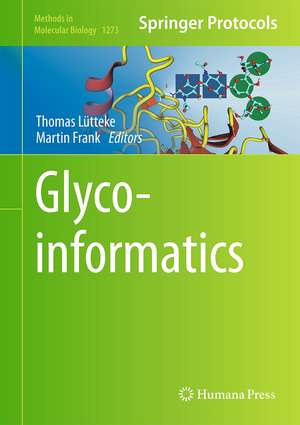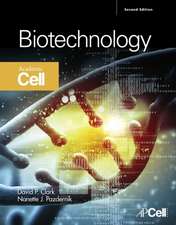Glycoinformatics: Methods in Molecular Biology, cartea 1273
Editat de Thomas Lütteke, Martin Franken Limba Engleză Hardback – 10 mar 2015
Authoritative and timely, Glycoinformatics demonstrates the progress that has been achieved in glycoinformatics, which indicates that it is no longer a niche subject covered by only a few scientists but is truly coming of age.
Din seria Methods in Molecular Biology
- 9%
 Preț: 791.59 lei
Preț: 791.59 lei - 23%
 Preț: 598.56 lei
Preț: 598.56 lei - 20%
 Preț: 882.95 lei
Preț: 882.95 lei -
 Preț: 252.04 lei
Preț: 252.04 lei - 5%
 Preț: 802.69 lei
Preț: 802.69 lei - 5%
 Preț: 729.61 lei
Preț: 729.61 lei - 5%
 Preț: 731.43 lei
Preț: 731.43 lei - 5%
 Preț: 741.30 lei
Preț: 741.30 lei - 5%
 Preț: 747.16 lei
Preț: 747.16 lei - 15%
 Preț: 663.45 lei
Preț: 663.45 lei - 18%
 Preț: 1025.34 lei
Preț: 1025.34 lei - 5%
 Preț: 734.57 lei
Preț: 734.57 lei - 18%
 Preț: 914.20 lei
Preț: 914.20 lei - 15%
 Preț: 664.61 lei
Preț: 664.61 lei - 15%
 Preț: 654.12 lei
Preț: 654.12 lei - 18%
 Preț: 1414.74 lei
Preț: 1414.74 lei - 5%
 Preț: 742.60 lei
Preț: 742.60 lei - 20%
 Preț: 821.63 lei
Preț: 821.63 lei - 18%
 Preț: 972.30 lei
Preț: 972.30 lei - 15%
 Preț: 660.49 lei
Preț: 660.49 lei - 5%
 Preț: 738.41 lei
Preț: 738.41 lei - 18%
 Preț: 984.92 lei
Preț: 984.92 lei - 5%
 Preț: 733.29 lei
Preț: 733.29 lei -
 Preț: 392.58 lei
Preț: 392.58 lei - 5%
 Preț: 746.26 lei
Preț: 746.26 lei - 18%
 Preț: 962.66 lei
Preț: 962.66 lei - 23%
 Preț: 860.21 lei
Preț: 860.21 lei - 15%
 Preț: 652.64 lei
Preț: 652.64 lei - 5%
 Preț: 1055.50 lei
Preț: 1055.50 lei - 23%
 Preț: 883.85 lei
Preț: 883.85 lei - 19%
 Preț: 491.88 lei
Preț: 491.88 lei - 5%
 Preț: 1038.84 lei
Preț: 1038.84 lei - 5%
 Preț: 524.15 lei
Preț: 524.15 lei - 18%
 Preț: 2122.34 lei
Preț: 2122.34 lei - 5%
 Preț: 1299.23 lei
Preț: 1299.23 lei - 5%
 Preț: 1339.10 lei
Preț: 1339.10 lei - 18%
 Preț: 1390.26 lei
Preț: 1390.26 lei - 18%
 Preț: 1395.63 lei
Preț: 1395.63 lei - 18%
 Preț: 1129.65 lei
Preț: 1129.65 lei - 18%
 Preț: 1408.26 lei
Preț: 1408.26 lei - 18%
 Preț: 1124.92 lei
Preț: 1124.92 lei - 18%
 Preț: 966.27 lei
Preț: 966.27 lei - 5%
 Preț: 1299.99 lei
Preț: 1299.99 lei - 5%
 Preț: 1108.51 lei
Preț: 1108.51 lei - 5%
 Preț: 983.72 lei
Preț: 983.72 lei - 5%
 Preț: 728.16 lei
Preț: 728.16 lei - 18%
 Preț: 1118.62 lei
Preț: 1118.62 lei - 18%
 Preț: 955.25 lei
Preț: 955.25 lei - 5%
 Preț: 1035.60 lei
Preț: 1035.60 lei - 18%
 Preț: 1400.35 lei
Preț: 1400.35 lei
Preț: 1024.59 lei
Preț vechi: 1280.74 lei
-20% Nou
Puncte Express: 1537
Preț estimativ în valută:
196.06€ • 205.22$ • 163.18£
196.06€ • 205.22$ • 163.18£
Carte tipărită la comandă
Livrare economică 31 martie-14 aprilie
Preluare comenzi: 021 569.72.76
Specificații
ISBN-13: 9781493923427
ISBN-10: 1493923420
Pagini: 475
Ilustrații: XVI, 506 p. 182 illus., 146 illus. in color.
Dimensiuni: 178 x 254 x 28 mm
Greutate: 1.45 kg
Ediția:2015
Editura: Springer
Colecția Humana
Seria Methods in Molecular Biology
Locul publicării:New York, NY, United States
ISBN-10: 1493923420
Pagini: 475
Ilustrații: XVI, 506 p. 182 illus., 146 illus. in color.
Dimensiuni: 178 x 254 x 28 mm
Greutate: 1.45 kg
Ediția:2015
Editura: Springer
Colecția Humana
Seria Methods in Molecular Biology
Locul publicării:New York, NY, United States
Public țintă
Professional/practitionerCuprins
Annotation of Glycomics MS and MS/MS Spectra Using the GlycoWorkbench Software Tool.- GlycoBase and autoGU: Resources for Interpreting HPLC-Glycan Data.- NMR Chemical Shift Prediction of Glycans: Application of the Computer Program CASPER in Structural Analysis.- Handling and Conversion of Carbohydrate Sequence Formats and Monosaccharide Notation.- Bacterial, Plant, and Fungal Carbohydrate Structure Databases: Daily Usage.- Using NMR Data on GLYCOSCIENCES.- Glycomic Analysis Using KEGG GLYCAN.- GlycomeDB.- Eukaryotic Glycosylation: Online Methods for Site-Prediction on Protein Sequences.- Analyzing Glycan Structure Synthesis with the Glycan Pathway Predictor (GPP) Tool.- Functional Network in Post-Translational Modifications: Glyco-Net in Glycoconjugate Data Bank.- JCGGDB: Japan Consortium for Glycobiology and Glycotechnology DataBase.- Glycan Array Data Management at Consortium for Functional Glycomics.- Analyzing Glycan Binding Patterns with the ProfilePSTMM Tool.- Exploring the Specificities of Glycan-Binding Proteins Using Glycan Array Data and the GlycoSearch Software.- Statistical Analysis of Amino Acids in the Vicinity of Carbohydrate Residues Performed by GlyVicinity.- Tools to Assist Determination and Validation of Carbohydrate 3D Structure Data.- Glyco3D : A Portal for Structural Glycosciences.- Solution Conformation of Carbohydrates: A View by Using NMR Assisted by Modeling.- Informing Saccharide Structural NMR Studies with Density Functional Theory Calculations.- Energy Maps for Glycosidic Linkage Conformations.- Conformational Analysis of Oligo- and Polysaccharides Using Molecular Dynamics Simulations.- Molecular Dynamics Simulations of Membrane- and Protein-Bound Glycolipids Using GLYCAM.- Lipopolysaccharide Membrane Building and Simulation.- Molecular Dynamics Simulations of Glycoproteins Using CHARMM.- Calculating Binding Free Energies for Protein-Carbohydrate Complexes.- Scoring Functions for AutoDock.- Structures of Glycans Bound toReceptors from Saturation Transfer Difference (STD) NMR Spectroscopy: Quantitative Analysis by Using CORCEMA-ST.- QM/MM Methods for Studying Enzymatic Reactions of Glycosyltransferases.
Textul de pe ultima copertă
This book provides current glycoinformatics methods and protocols used to support the determination of carbohydrate structures in biological samples as well as carbohydrate structure databases, the interaction of carbohydrates with proteins, and theoretical and experimental methods to study their three-dimensional structure and dynamics. Glycoinformatics explores this recently emerged field, which has come into being in order to address the needs of encoding, storing, and analyzing carbohydrate ‘sequences’ and their taxonomy using computers. Written in the highly successful Methods in Molecular Biology series format, chapters contain the kind of detailed description and key implementation advice to ensure successful results.
Authoritative and timely, Glycoinformatics demonstrates the progress that has been achieved in glycoinformatics, which indicates that it is no longer a niche subject covered by only a few scientists but is truly coming of age.
Authoritative and timely, Glycoinformatics demonstrates the progress that has been achieved in glycoinformatics, which indicates that it is no longer a niche subject covered by only a few scientists but is truly coming of age.
Caracteristici
Includes cutting-edge techniques for glycoinformatics studies Provides practical detail essential for reproducible results Contains key notes and implementation advice from the experts










